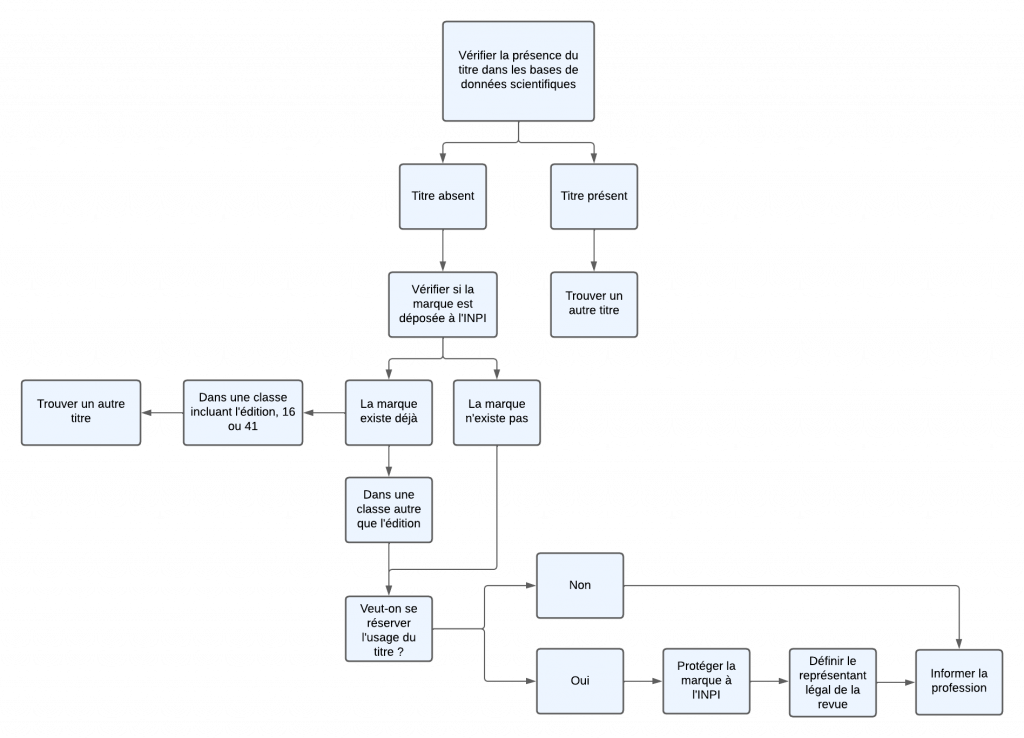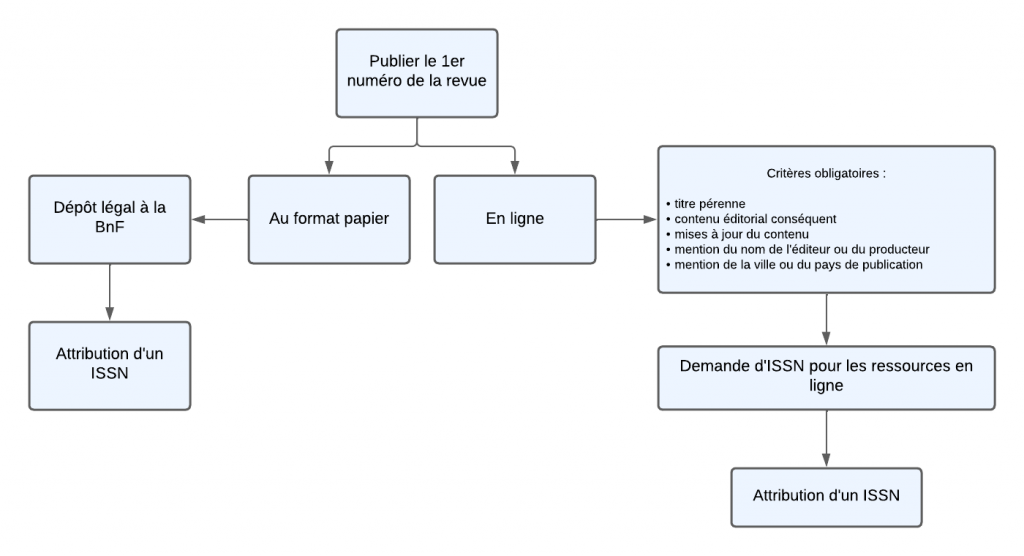Identification of the journal and legal obligations
Availability and ownership of the title
The first step is to define the title of the journal. It is therefore a question of:
- check the availability of the title: simply type the desired name into a search engine or check the worldwide trademark database.
- And, if necessary, it is possible to officially protect the title by registering it as a trademark via the INPI for France or via the Madrid system for other countries (a system that allows a single application to be made for a maximum of 128 days’ protection, renewable).
This is not required, but it allows the title to be declared so that no one else can use it (and thus protect oneself from predatory journals, which choose titles that are similar or even identical to existing journals), and to determine its owner.
This is the responsibility of the legal publisher, so if you wish to protect your title, you will need to determine who owns the title.

Get an ISSN
All journals distributed to the public must obtain an ISSN number. The ISSN (International Standard Serial Number) is an international standard code that unambiguously identifies a journal. It is this code that will make the difference between two different journals with the same title for example.
Each distribution format must have its own ISSN: if a journal has both a print and a digital format, it will have an ISSN for the print version and an e-ISSN for the digital version. In the event of a change of title, a new ISSN must be requested.
Each country has a national entity responsible for assigning ISSN:
- For French journals, the BNF assigns the ISSN. It is therefore with this institution that a request must be made when creating a new journal, either through legal deposit in the case of a paper journal, or by filling in a form for online journals
- For the British, it is the British Library
- For the Netherlands, the National Library of the Netherlands
- To find your centre according to your country, click here: ISSN membership map

Legal deposit
- If the journal is published in paper format, legal deposit automatically results in the attribution of an ISSN when the first issue is submitted. Thereafter, the publisher must send a global annual declaration each year when the last issue is published.
- If the journal is published online, there is no need to do anything. The BNF carries out automatic collections thanks to robots.

Legal publisher
Need for a publishing entity
Any scientific journal must be legally supported by a publisher.
The publisher edits (chooses and disseminates the content of a publication) and is legally responsible for the content of everything it publishes. It is therefore responsible for the civil and criminal liability of the published content.
Who can be an publisher?
A non-profit organisation, a university, an association, a foundation and even an individual.
The legal publisher is an entity often dissociated from the editorial team or from the person who carries the journal project.
The roles of publisher and publication director
The legal publisher is represented by a publication director, i.e. a natural person who assumes civil and criminal responsibility for the published content.
- For a laboratory, library, university press, university: the president of the university.
- For an association: the president of the association.
The publication director will be the natural person legally representing the legal entity publishing the journal. « En d’autres termes, le directeur/la directrice de la publication n’est donc pas nécessairement le directeur/la directrice de la revue, ni celui ou celle exerçant les missions de responsable scientifique. Il n’est pas non plus nécessairement la personne qui contractualise avec les auteurs. » (https://hal.archives-ouvertes.fr/hal-01960919v2/document)
Required information
The mandatory information differs between the printed and the digital version. This is due to the difference in support. Thus, for example, the printed magazine is subject to legal deposit. It is therefore possible to indicate the date of the latter. The digital version is done by harvesting: it is therefore impossible to indicate a legal deposit date.
Legal notice for the printed version:
- if the publisher is a legal person, its name or corporate name, its legal form, the address of its registered office, the name of its legal representative and its three main partners;
- if the publisher is not a legal entity, the full name and address of the owner or principal co-owner;
- the name of the director of the publication and of the editor;
- the name (or company name) and address of the printer;
- the date of publication ;
- the words “Legal deposit” followed by the month and year of deposit (provisional);
- the price in euros;
- the ISSN number assigned after the first deposit.
Legal notice for the digital version:
- the words “Director of Publication” followed by his/her first and last name
- the name, address and telephone number of the website host, the e-ISSN, if one has been assigned to the electronic version of the journal;
- the name, official address, telephone number of the legal entity publishing the journal (whose legal representative is mentioned as the director of the publication), as well as its share capital and its registration number in the RCS (Trade and Companies Register), if applicable: SA, SAS, SARL, GIE…
On the magazine’s website, this information often appears in the “Legal Notice” section.
Data protection
The Règlement Général sur la Protection des Données (RGPD), which came into force on 25 May 2016, requires individuals to be informed about the processing of their personal information. Thus, in the context of a publishing activity, working with authors involves the collection and processing of personal data.
The review must therefore ensure that this regulation is applied and respected.
Publication agreements/contracts
The author has de facto moral and economic rights to his work. As a result, the legal publisher, in order to be able to exploit his work (distribute the work, modify it, adapt it to the chosen medium, etc.), must obtain the author’s permission via a contract for the transfer of rights or publishing contract.
The contract for the transfer of rights must be concluded in writing between the author and the publisher. It must include certain mandatory information:
- the rights assigned: reproduction, adaptation, distribution, representation, modification, translation, etc.
- the scope, purpose, location and duration of the rights assigned
- method of calculation and payment of the assigned right
In France, the complete transfer of one’s copyright is not legal. According to the Code de la propriété intellectuelle, the right of authorship is “perpetual, inalienable and imprescriptible”. (Article L121-1 du Code de la propriété intellectuelle).
The author must specify the exclusive or non-exclusive nature of the assignment. A non-exclusive licence agreement allows the author to distribute his work in parallel or to grant the right of distribution to another editor.
For more information:
- In their article Recommandations et aspects juridiques relatifs à la création et à la diffusion d’une revue scientifique – V2, Céline Barthonnat, Cécile Beauchamps, Odile Contat, Anne-Laure Stérin and Céline Vautrin detail the various legal obligations related to the creation of a journal. We offer here a synthesis of this document.
- Toolkit to foster Open Access Agreements : examples of contracts.
- Nuts and Bolts: The Super Long List of Things to Do When Starting a New Journal.


